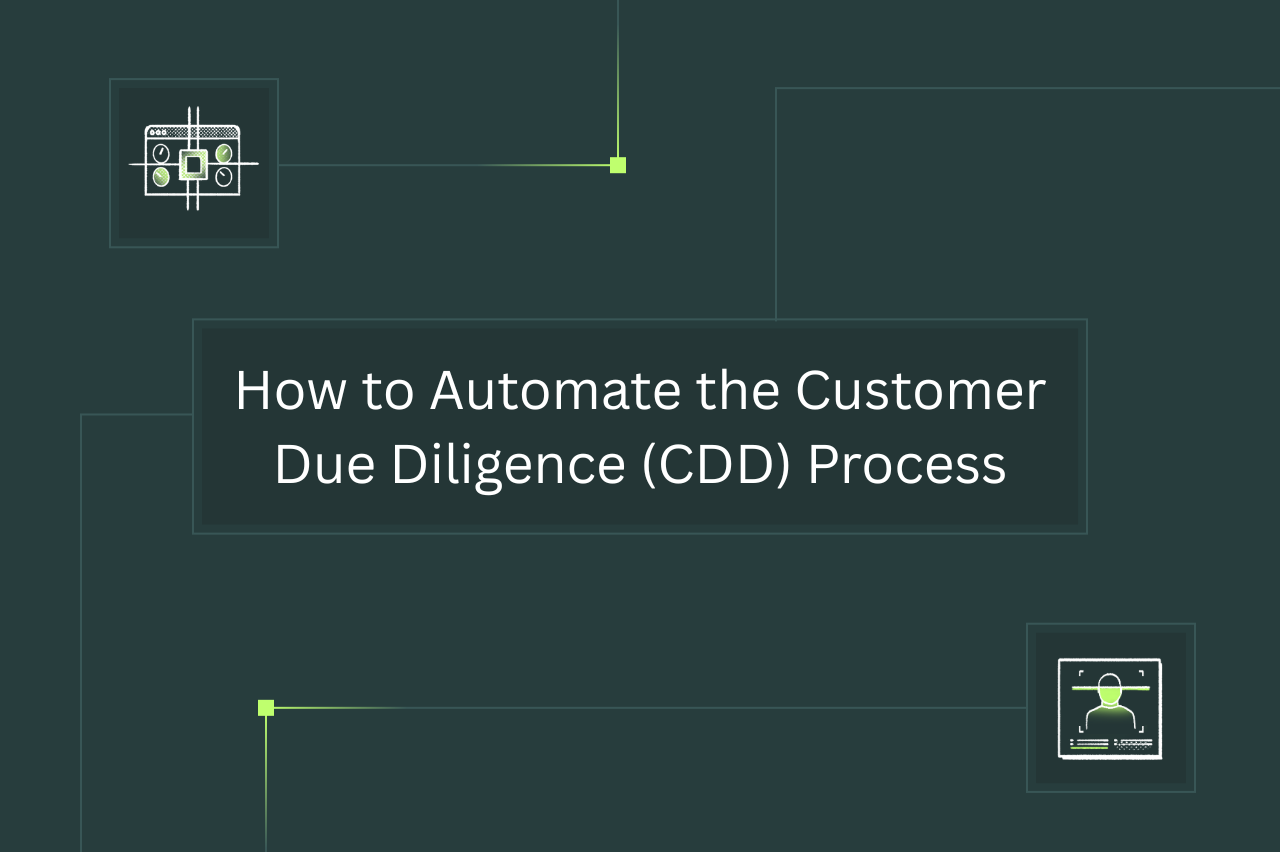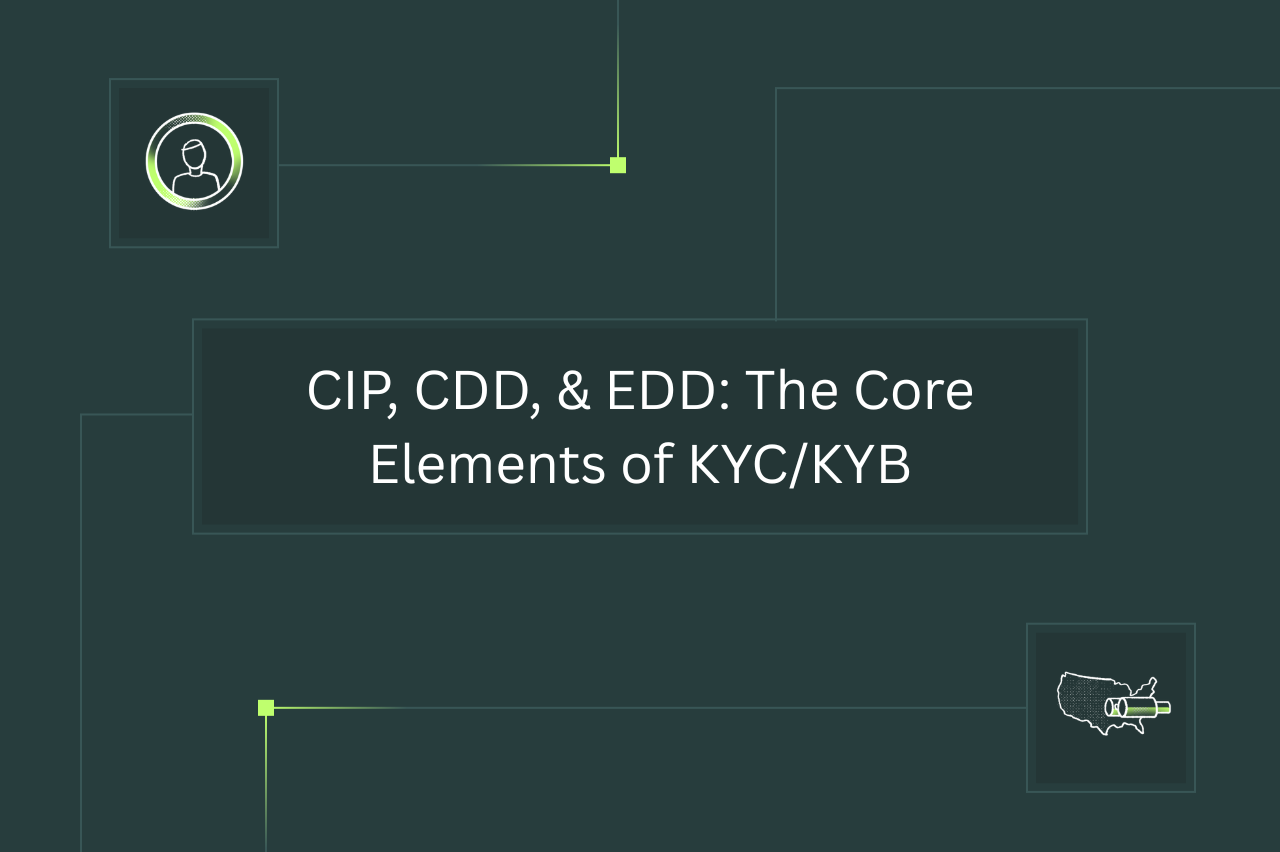In brief:
- CDD automation involves using digital solutions to streamline the Customer Due Diligence process when starting or reviewing a client/partner relationship.
- Automating CDD is important because it speeds up your onboarding process while reducing costs.
- Some of the parts of the CDD process that can be automated include data gathering, watchlist screening, risk assessment, ongoing activity monitoring, and regulations compliance.
Customer Due Diligence—or CDD—is an important part of an organization starting—and maintaining—relationships with its customers. It involves checking numerous information sources for indicators that an entity’s status or activities could pose an unacceptable level of risk to an organization.
For organizations with large-scale operations, CDD is too resource-intensive to perform completely manually when they may have thousands of customers. That’s why many turn to modern solutions to automate CDD, along with other Know Your Business (KYB) and Know Your Customer (KYC) processes.
This article discusses how this automation is achieved, and what critical advantages it offers organizations.
- What is Customer Due Diligence (CDD) automation?
- Why CDD automation is so important
- How to automate CDD for business verification
First, we review what Customer Due Diligence is and explain what it means to automate it.
When we talk about CDD automation, we’re referring to the process of automating the Customer Due Diligence process, or at least some components of it. This has many advantages that allow organizations to onboard and manage customers at scale.
Automation is achieved mostly through the use of modern solutions that retrieve data from relevant sources, evaluate information to determine risk levels, make CDD decisions based on customized rules, and alert risk teams of suspicious activity that requires further investigation.
Automating CDD is a near necessity for many organizations. It allows them to not only onboard customers faster and in larger volumes, but also manage and review customer relationships in the face of changing regulatory requirements and industry conditions. Automating CDD processes significantly improves efficiency, saving teams resources, time, and money.
Here are eight ways automating CDD helps:
- Speed up data gathering: CDD requires consulting several different types of information sources to check for risk indicators. Gathering and processing this information takes much less time when done by an automated solution as opposed to manually.
- Evaluate more data sources: Since automation makes gathering data from sources take less time, it also allows for drawing from more sources overall. This allows for a more thorough CDD analysis that avoids failing to review potentially relevant sources and data due to time constraints.
- Mitigate the chance of human error: Modern solutions are ideal for automating repetitive, menial tasks in processes like CDD. They can be counted on to perform these tasks the same way every time. In contrast, if the tasks are done manually, inevitable human mistakes can potentially lead to compromised data quality and faulty decision-making.
- Reduce onboarding friction: Too much manual work slows down onboarding, which can frustrate a customer and even cause them to abandon the process altogether. Automation speeds things up, leading to happier customers and a greater overall volume of onboarded clients.
- Ensure compliance with regulations: Automated solutions can be programmed to conform to at least minimum industry-specific CDD regulatory standards. This helps to avoid regulatory penalties and other operational risks from non-compliance. They can also be set up to create records of all compliance-related activities, providing evidence of work done in case of an audit.
- Simplify ongoing monitoring: CDD is a continuous process, as changing regulations and client situations can prompt reviews. Having automation tools like a KYB API makes this process easier by signaling (or even implementing) regulatory updates and performing checks in the background.
- Customization to fit specific organization needs: Beyond being tuned for minimum compliance, automated CDD systems can be adjusted to perform additional checks in certain risk areas. An organization may determine it’s more vulnerable in these areas based on industry conditions, its own overall customer risk profile, and more.
- Conserve resources for other work: Money and human resources saved by automating CDD (and other such processes) can be spent by an organization on other projects. These may include priority high-risk KYC/KYB cases that require Enhanced Due Diligence (EDD), methods of streamlining customer experiences, or new products that expand the organization’s offerings and audiences.
{{gated-content-block="/events/american-banker-automating-yes"}}
There are several tasks within the CDD process that can be automated to conserve resources and avoid mistakes. Here are a few examples, along with technologies and strategies that can be used to implement the automation.
Contextual data gathering
Beyond strictly ID documents, there are other sources of information compliance teams need to look at for KYC or KYB—and specifically CDD. These include credit reports, criminal records, adverse media, transaction histories, and web presence. Setting up a CDD solution to automatically check these relevant sources may take extra time at first, but it will pay off in the long run in at least two ways.
One is that compliance team members won’t have to remember to check each source individually. The other is that your organization will get a clearer picture of who a customer is, what they’re doing, and how much risk they represent.
Be sure to research which specific sources are reliable and trustworthy in order to preserve data integrity. Middesk sources business data directly from U.S. Secretary of State offices, among other official government sources, so you can confidently rely on the data you get.
Watchlist screening
A key risk indicator for a customer is whether they are on a watchlist. These are lists of people, companies, or even countries that are under increased surveillance for the potential to commit crime, or have been deemed outright illegal to deal with (usually due to committing a crime). An automated CDD system, such as Middesk’s watchlist screening software, can quickly check a customer’s information against these lists.
It’s important to remember that watchlists are relevant to your organization, and can sometimes differ between industries. You should also check the client’s nationality as part of their ID when screening for watchlist hits, even if the client doesn’t appear on a list individually, as the country where they’re located may appear on a high-risk or sanctioned list, and checking this efficiently requires sanction screening software.
Activity monitoring
A customer may not keep the same risk profile as it did when it was onboarded. Middesk can help with this using our Monitoring product to update your organization on relevant changes to an entity’s status that could affect its risk profile, or make them outright illegal to deal with.
Regulatory compliance
Part of the challenge of complying with CDD regulations is that they change rather frequently. Fortunately, many automated CDD systems can be set up to alert compliance teams to changing regulatory rules.
Another thing an automated CDD solution should be set up to do is automatically create records of any and all CDD (including EDD) activities. Regulatory bodies will occasionally conduct audits to ensure compliance teams are actually taking the necessary steps to detect and prevent criminal abuse of their organization’s services. Having an automated record trail will serve as evidence that a compliance team has been doing its job.
Middesk’s Business Verification solution puts a wealth of information needed for assessing B2B relationship risks at your organization’s fingertips. This includes watchlist screening, adverse media screening, industry classification, web presence, litigations, bankruptcies, liens, and more.
Set up a demo to learn more about how we can streamline your KYB operations, including CDD. If you want to see it right now, check out our on-demand product demo of Middesk Verify to see how it can automate your CDD verification process:
{{gated-content-block="/events/productdemo-verify-june-2025"}}










